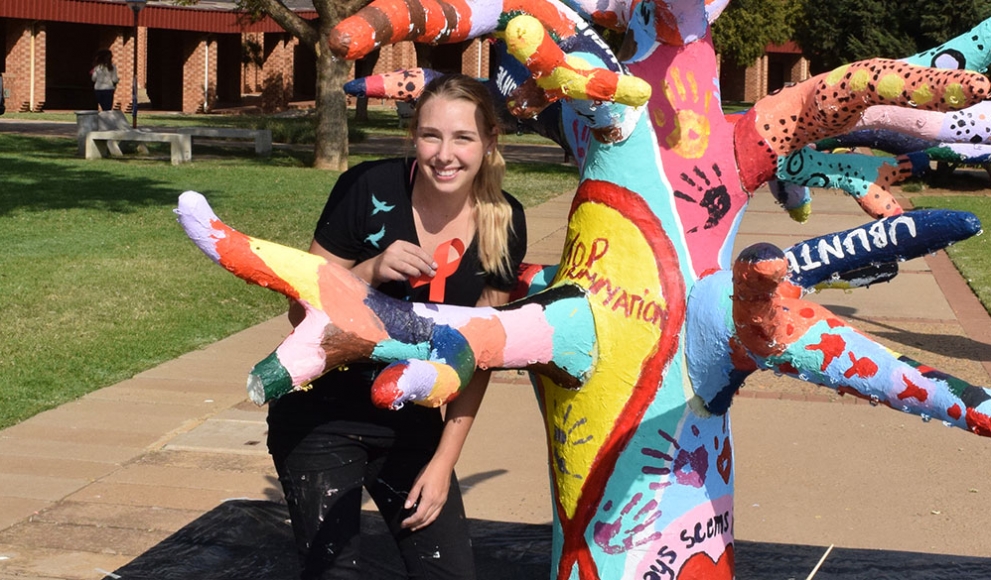Michelle Vogelzang '13 Created the AIDS SolidariTree, an Interactive Sculpture to Help Promote Understanding at This Year's International AIDS Conference

This year's International AIDS Conference, held in Durban, South Africa, from July 18 to 22, will feature a unique art installation developed by Michelle Vogelzang '13. Vogelzang used Kickstarter to crowdfund the AIDS SolidariTree, which was created in Lesotho and painted in neighboring South Africa. Conference attendees will be invited to add red paper ribbon "leaves" to the tree, on which they can write messages of encouragement or share their own stories of living with the disease.
"My hope is that those with HIV interacting with the piece will take courage and strength from the messages of support from thousands who want to end HIV discrimination," said Vogelzang, who grew up in Durban and now lives in Lesotho. "For those who are not HIV positive, my hope is that the story of the tree and the messages on the leaves encourage people to learn more about HIV and commit to end stigma and discrimination, starting with themselves."
That story began in February, when Vogelzang worked with a local sculptor in Durban to design the tree. It resembles Africa's mighty baobab tree and is made from repurposed materials, including chicken wire and the dense, lightweight foam used to make surfboards in Durban. After its base was completed in late June, Vogelzang invited 91 children who were attending a camp in Thaba Bosiu, Lesotho, to help cover it with papier-mâché. The tree was then transported to Pretoria, South Africa, where a group of 20 high-school students painted the structure during another camp directed by Mische Kang '13.
In both locations, participants had the chance to attend discussions and lectures about how to address HIV stigma in their communities. (Approximately 23 percent of the population in Lesotho and 19 percent of the population in South Africa have HIV.) The high-schoolers also took photographs depicting life in their communities, which will be displayed at the International AIDS Conference.
"HIV in Africa is still very much associated with death, even though there are now many people who have been living with HIV for years," said Vogelzang. "This association and fear due to the lack of information perpetuates a stigma that leads to discrimination against people with HIV."
For Vogelzang, the tree project is a natural outgrowth of the advocacy work she began at Wellesley. A peace and justice studies and biological sciences double major, Vogelzang covered the grass in the academic quad with hundreds of red paper pinwheels that formed the shape of an AIDS ribbon in honor of World AIDS Day 2012. She and other Wellesley students also hung posters around campus with facts and information about HIV and AIDS.
"I grew up in a country with some of the worst HIV and TB infection rates in the world and where easy access to good health care was a privilege few had," she said. "I was always aware of the effect that a disease could have on society, how it could decrease the productivity of our workforce and alter family relationships, for example, forcing young people to put aside education and become heads of households."
Her course work at Wellesley, and her experience as an Albright Scholar in 2012, taught her how to effectively approach the challenges that HIV stigma and other complex problems present. "Ultimately, I came away from Wellesley believing in the need to better engage marginalized groups and to ensure cultural understanding in order to avoid some of the historical pitfalls in international development and policy interventions," she said.
The AIDS SolidariTree reflects the holistic thinking she learned at the College, said Vogelzang, who in addition to her work on the tree supports the Ministry of Health in Lesotho on behalf of a major international NGO. "I think tackling stigma is an effective way to get more people testing for HIV, taking treatment, and sharing their status with others," she said. "I also hope that women and girls feel empowered to make decisions about their health—for example, negotiating the use of condoms with a partner."
Vogelzang said she is delighted by the finished tree, which stands about 8 feet tall and is 6.5 feet wide, but to her, the sculpture is less an art piece than a form of community activism. "The project is about people standing in solidarity to end HIV stigma and discrimination," she said. "It's about how many people we can involve along the way."
